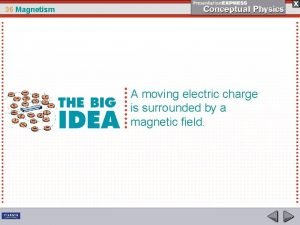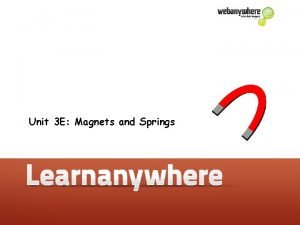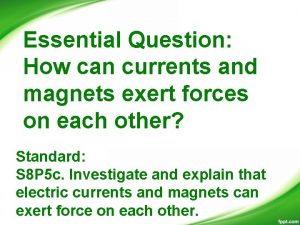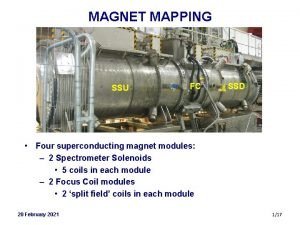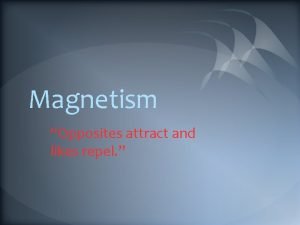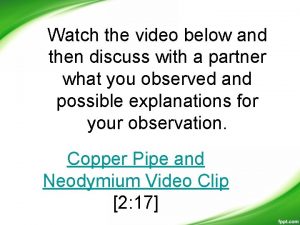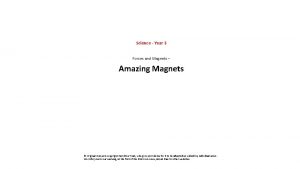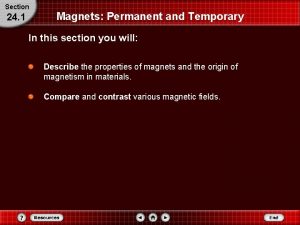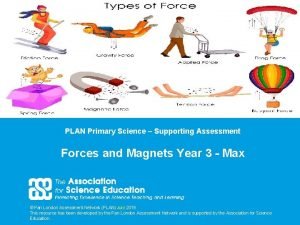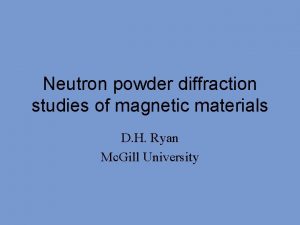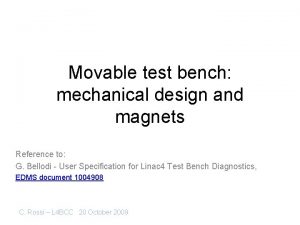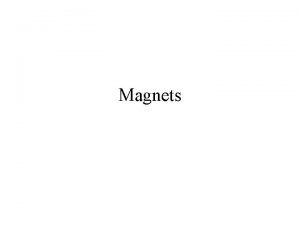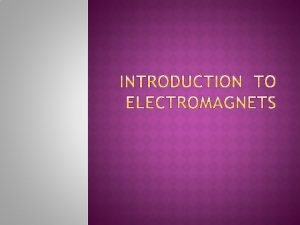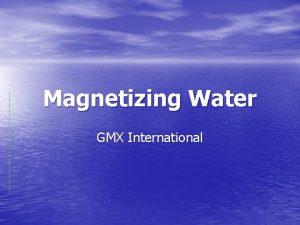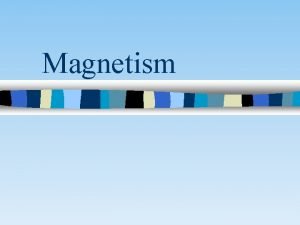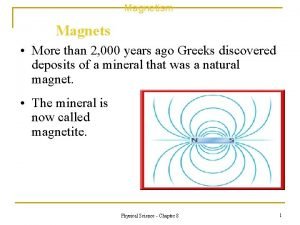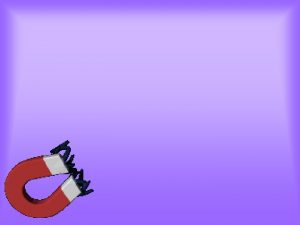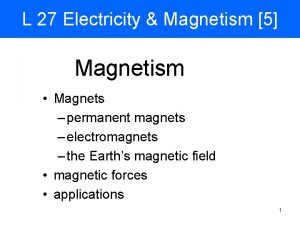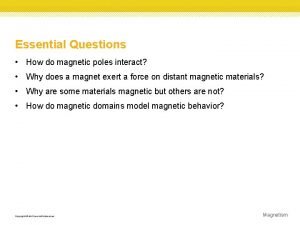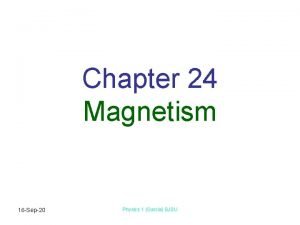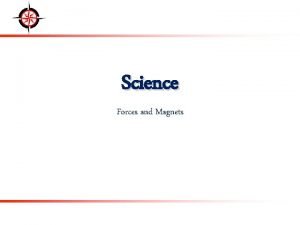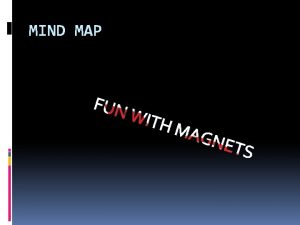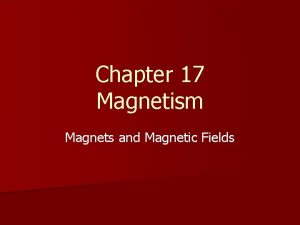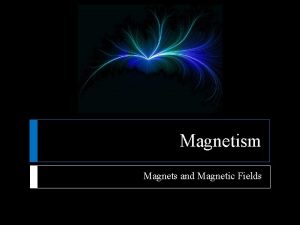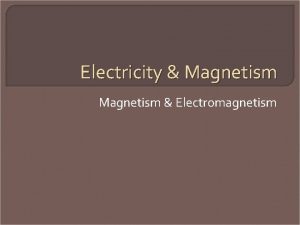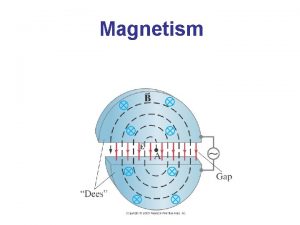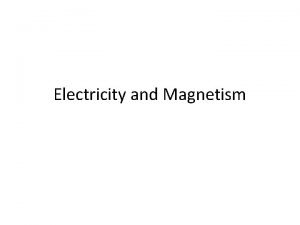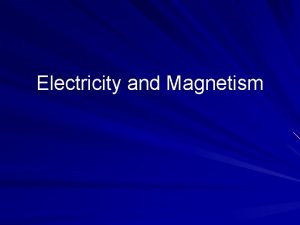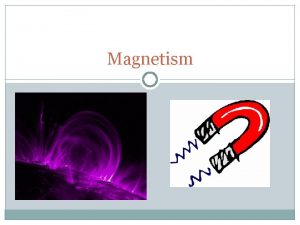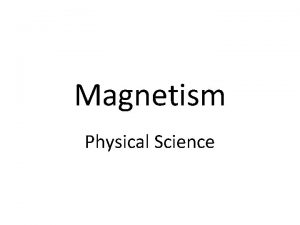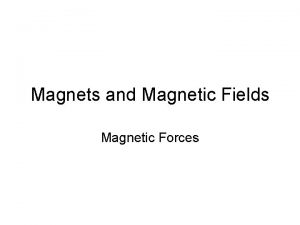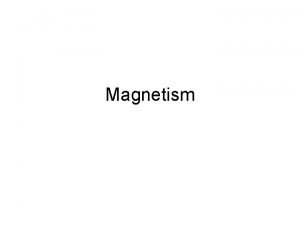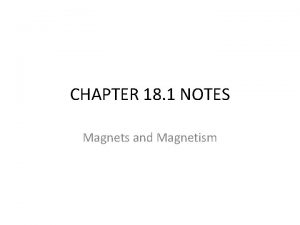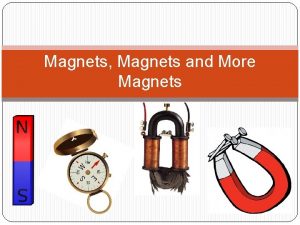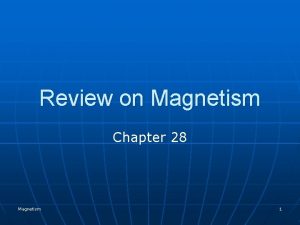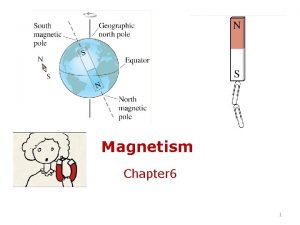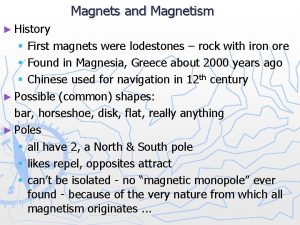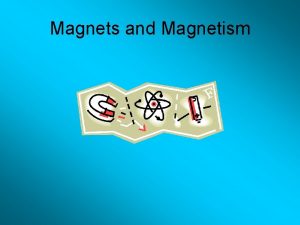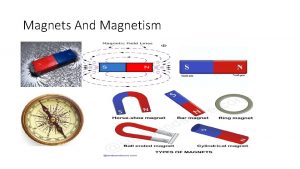Chapter 21 Magnetism 21 1 Magnets and Magnetic
































- Slides: 32

Chapter 21 Magnetism

21. 1 Magnets and Magnetic Fields Objectives 1. For given situations, predict whether magnets will repel or attract each other 2. Describe the magnetic field around a permanent magnet 3. Describe the orientation of Earth’s magnetic field

Magnetic Poles …are similar to electric charges because like poles repel and unlike poles attract

More on Magnetic Poles While electric charges can be separated from each other, magnetic poles cannot. No matter how many times you cut a permanent magnet, it will still have a N pole and a S pole. So, magnetic poles ALWAYS occur in pairs.

Magnetic Materials Hard magnets: materials that are difficult to magnetize, but once they are they tend to retain their magnetism (examples, cobalt and nickel) Soft magnets: materials that are easy to magnetize, but they also tend to lose their magnetism easily. (example, iron)

Magnetic Field • The magnetic field is denoted by the letter B • The direction of the magnetic field at any location is defined as the direction a compass needle would point at that location (N) • The magnitude of the magnetic field is greatest close to the poles

Magnetic Declination The difference between the Earth’s geographic N pole (true north) and the magnetic N pole (indicated on a compass) is called magnetic declination.

Earth’s Magnetic Field • The Earth’s magnetic field is created by interactions between the inner core and outer core. • The inner core is solid iron and the outer core is liquid. • The inner core spins at a different rate than the outer core, which creates a dynamo effect, or convections and currents within the core. • These convections and currents create the Earth’s magnetic field.

More on the Earth’s Magnetic Field • The earth’s magnetic field protects it against solar winds from the sun. The charged particles in the solar winds are deflected by the field. • Without the Earth’s magnetic field, the solar winds would blow away our atmosphere.

Aurora Borealis • Caused by collisions of charged particles from solar flares • The colors are caused by ionization of nitrogen and oxygen in the Earth’s atmosphere • Most commonly seen closer to the poles due to longer periods of darkness and greater magnetic field strength • Geomagnetic storms occur most often in the months surrounding the equinoxes

Does the Earth’s Magnetic Field Change? • The North pole is moving toward Russia at a rate of ~40 mi/year • On a compass, this equates to ~0. 2 o/yr

Reversal of Earth’s Magnetic Poles • Last time it occurred was ~780, 000 years ago • Takes anywhere from 1, 000 -10, 000 years to complete

21. 2 Electromagnetism and Magnetic Domains Objectives 1. Describe the magnetic field produced by the current in a straight conductor and in a solenoid 2. Explain magnetism in terms of the domain theory of magnetism

Magnetic Field and Electric Charge • The region of space surrounding a moving charge contains: An electric field (E) A magnetic field (B) Both fields have a defined magnitude and direction

Magnetic Field Surrounding a Current-Carrying Wire • Because a wire carries a current (I), it produces a magnetic field • The direction of the magnetic field (B) can be found using the Right Hand Rule

Magnetic Field Surrounding a Current-Carrying Wire • The current produces concentric circles of magnetic field lines around the wire • The magnetic field strength (B) is directly proportional to the current in the wire and inversely proportional to the distance from the wire

Magnetic Field Surrounding a Current-Carrying Loop • The right hand rule applies for the direction of the magnetic field for a looped conductor

Looped Conductors Solenoid – a long, helically wound coil of insulated wire, which acts as a magnet when carrying a current

Looped Conductors, cont. Electromagnet – a solenoid with an iron rod inserted into the core. The magnetic field induced into the rod adds to the magnetic field of the solenoid.

Electromagnetic Induction • Discovered by Michael Faraday • A moving electrical current creates a magnetic field (motors) • A moving magnetic field creates an electrical current (generators)

Magnetic Domains • Domain – a microscopic magnetic region composed of a group of atoms whose magnetic fields are aligned in a common direction • In hard magnetic materials, the domains persist after the external magnetic field is removed, resulting in a permanent magnet.

21. 3 Magnetic Force Objectives 1. Given the force on a charge in a magnetic field, determine the strength of the magnetic field 2. Use the right hand rule to find the direction of the force on a charge moving through a magnetic field 3. Determine the magnitude and direction of the force on a wire carrying current in a magnetic field

Magnetic Force and Electric Charges • A stationary charged particle (q) does not interact with a constant magnetic field • A charged particle (q) that is moving at a velocity (v) through a magnetic field (B) experiences a magnetic force (Fmagnetic) Fmagnetic = qv. B Note: q is assumed to be a positive charge

Magnitude of Magnetic Force Rearranging Fmagnetic = qv. B, we get B = Fmagnetic / qv The units for B are Teslas (T) where 1 T = 1 N/(C*m/s) = N/(A*m) = (V*s)/m 2

Directions of B and Fmagnetic Using your right hand, if you point your fingers in the direction of the magnetic field (B), and your thumb in the direction of the charge movement (v), then the force on the charge (Fmagnetic) will point out of your palm for a positive charge. (Into your palm for a negative charge)

More on Directions of B and Fmagnetic

Magnetic Field (B) Directions • When the field is INTO the page, use X • When the field is out of the page, use • When the field is in the plane of the page, use .

Question A proton moving east at 1. 0 x 105 m/s experiences a force of 8. 8 x 10 -19 N upward (away from Earth). What is the magnitude and direction of the Earth’s magnetic field at this location? For magnitude: B = Fmagnetic/qv For direction: Use RHR with palm facing up for the force and thumb facing east for the velocity. Your fingers point in the direction of the magnetic field. Answer: 5. 5 x 10 -5 T, north

Charge moving in a magnetic field The magnetic field (B) is going into the page The velocity of the charge (v) is perpendicular to B The force exerted on the charge (Fmagnetic) due to B at location O is upward As the charge keeps moving it is continually deflected inward, resulting in a circular path

Magnetic Force on a Current. Carrying Conductor A current-carrying conductor in a magnetic field experiences a force that is perpendicular to the direction of the current

Magnetic Force on a Current. Carrying Conductor Fmagnetic = BIL B is the magnitude of the magnetic field I is the current L is the length of the conductor within B

Question A wire 36 m long carries a current of 22 A from east to west. Find the magnitude and direction of the force on the wire if the magnetic field of the Earth at this location is directed from S to N and has a magnitude of 5. 0 x 10 -5 T. Magnitude: Fmagnetic = BIL Direction: Use RHR with thumb facing west (for current direction) and fingers pointing north (for magnetic field direction) Answer: 4. 0 x 10 -2 N downward (toward Earth)
 Conceptual physics magnetism
Conceptual physics magnetism Magnetism lesson outline answer key
Magnetism lesson outline answer key Magnetic field lines on a bar magnet
Magnetic field lines on a bar magnet Magnetic permeability of materials
Magnetic permeability of materials Unit of magnetic flux is weber
Unit of magnetic flux is weber Magnetic moment and magnetic field relation
Magnetic moment and magnetic field relation Magnetic force particle
Magnetic force particle Chapter 36 magnetism answer key
Chapter 36 magnetism answer key Magnets and springs
Magnets and springs The properties and interactions of magnets
The properties and interactions of magnets How do currents and magnets exert forces on each other
How do currents and magnets exert forces on each other Ssu fc
Ssu fc Magnetism opposites attract
Magnetism opposites attract Electromagnet in speakers
Electromagnet in speakers Amazing magnets fishing magnet
Amazing magnets fishing magnet Electromagnet
Electromagnet Magnets for year 3
Magnets for year 3 Temporary vs permanent magnets
Temporary vs permanent magnets Why do magnets repel
Why do magnets repel 642008419
642008419 Amazing magnets
Amazing magnets Why do magnets repel
Why do magnets repel Are electromagnets permanent or temporary
Are electromagnets permanent or temporary Gmx 800 magnetic fluid conditioner
Gmx 800 magnetic fluid conditioner Natural magnets examples
Natural magnets examples A single wire wrap into a cylindrical wire coil is called
A single wire wrap into a cylindrical wire coil is called Iodestones
Iodestones An invisible pulling force
An invisible pulling force How are permanent magnets formed
How are permanent magnets formed Why do magnets repel
Why do magnets repel Mr garcia uses magnets
Mr garcia uses magnets Amazing magnets
Amazing magnets Magnets applications
Magnets applications







